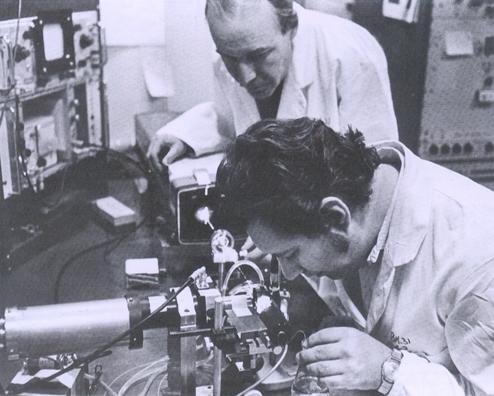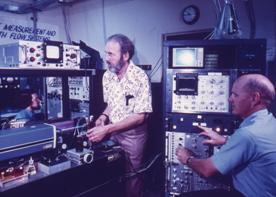Home Research Centers Los Alamos

Los Alamos
by Scott Cram, Marv Van Dilla, Jim Jett, and Harry Crissman
In the early 1960’s Marv Van Dilla was applying gamma ray spectroscopy to biological and medical problems when Mack Fulwyler joined the group. Wright Langham asked Mack and Marv to help a pathologist in the group, CC Lushbaugh, to extend the capability of the newly invented Coulter red blood cell counter to the measurement of red blood cell size distributions. This got Mack and Marv into a new field, namely, high speed detection of the properties of cells in aqueous suspension. Work on this problem led Mack to the brilliant insight to combine the Coulter counter concept with the principle of electrostatically deflected ink jets developed by Dick Sweet at Varian Corporation as a high speed oscillograph. The result of this ingenious combination of ideas was Mack’s first flow sorter, whereby cells of a particular size could be physically separated out of a mixture containing a variety of cell sizes, and at high speed (Electronic Separation of Biological Cells by Volume – 1965 Science paper ).
).
At the same time, Marv was developing a flow cytometer to measure fluorescence signals from cells stained with specific fluorescent dyes to mark cellular DNA content. Then Paul Mullaney joined the group in 1966 to extend flow systems to measure light scattering by cells.
Helping all these efforts were Jim Coulter, Ted Trujillo, Phil Dean and Dick Hiebert. Constant support and encouragement by Wright Langham was invaluable. These optical flow cytometers proved successful, and Mack incorporated them into flow sorting. This enabled the high speed analysis and separation of cells in suspension based on both electrical (size) and optical signals (including fluorescence, which could be markers for a wide variety of cellular properties). In 1969 John Steinkamp, Dale Holm and Scott Cram joined the group to work on, respectively, advanced integration of optical, electronic, and high speed sorting and high resolution DNA measurements of normal and tumorigenic cells.

John Steinkamp’s flow cytometer to measure time-resolved fluorescence at the NFCR, Los Alamos. Photo contributed by Dave Coder.
The early 70’s saw the effort expand in many ways, including but not limited to Jim Jett working with Phil Dean to develop the famous Dean and Jett histogram analysis algorithm for resolving G1, S, and G2+M cells; Harry Crissman developing one of the first high resolution DNA analysis staining procedures; Gary Salzman, understanding multiangle light scatter based on both experimental and theoretical basis; and John Martin, who integrated all these capabilities into user friendly instruments for high resolution analysis and reliable sorting to support a rapidly expanding user community.

Harry Crissman (foreground) and Marv van Dilla preparing to analyze DNA content in stained cells in the single parameter flow microfluorometer (FMF) at Los Alamos National Laborotory in the early 1970s. The term FMF was used to describe the instrument at that time, before the name was later designated to be a flow cytometer (FCM). Photo contributed by Harry Crissman.

A hike into the Sangre de Cristo Mountains, just north of Santa Fe, NM, by members of the Los Alamos Flow Cytometry Group, 1971. Photo contributed by Al Brunsting.
Have a look at Los Alamos Scientific Laboratory Annual Reports and publications from the 1960s and 1970s, including Fulwyler’s report that the particle separator is in principle capable of separating by volume, optical density or fluorescence. Contributed by Bob Auer.

Joe Gray at LLNL in mid 1970s. Photo contributed by Phil Dean.

Marv Van Dilla and Phil Dean sorting chromosomes at LLNL around 1978, on the first fluorescence-based sorter developed there. The sorter shown was later modified to become the first dual-beam, fully computer-controlled, multi-parameter sorter. Photo contributed by Phil Dean.
